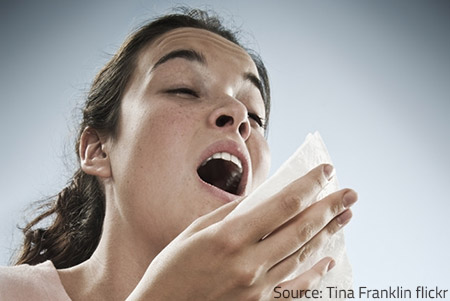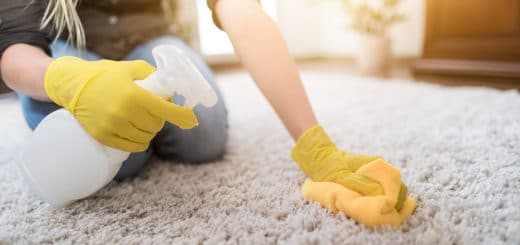Can Mold Form on Concrete Surfaces?
MoldMold is a type of fungus that grows in damp or humid conditi... More can easily grow on concrete and cement surfaces, especially walls, due to their porousPorous describes a material that contains small openings or ... More nature. When conditions are right, moldMold is a type of fungus that grows in damp or humid conditi... More can spread quickly. It’s crucial to deal with moldMold is a type of fungus that grows in damp or humid conditi... More on concrete promptly to avoid it becoming a major problem for your home or business. In this discussion, we’ll explore why moldMold is a type of fungus that grows in damp or humid conditi... More grows on concrete, the dangers it presents, and effective ways to prevent future moldMold is a type of fungus that grows in damp or humid conditi... More outbreaks. By doing so, you can prevent costly damage and the need for extensive restorationRestoration is the process of returning a property to its pr... More work.
How to Identify Mold on Concrete?
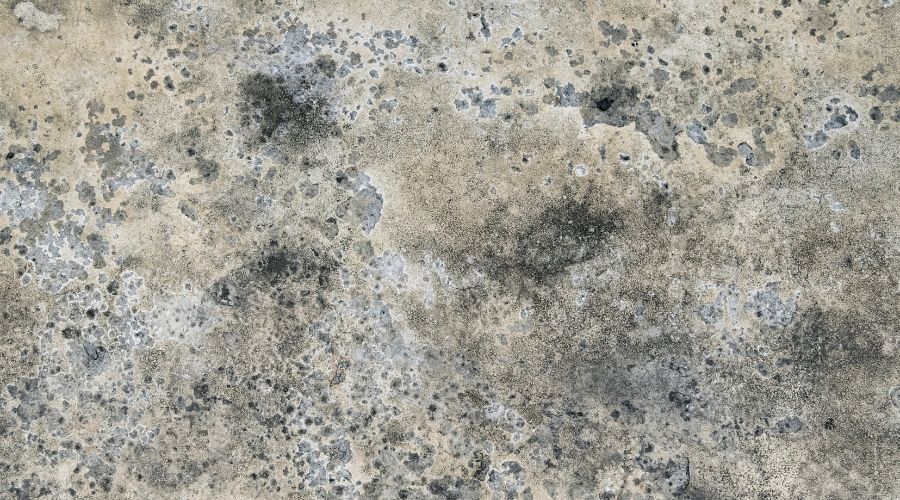
Identifying moldMold is a type of fungus that grows in damp or humid conditi... More on concrete is quite straightforward. It often resembles moss or algae, though its appearance can vary based on the type of moldMold is a type of fungus that grows in damp or humid conditi... More and its duration on the surface. Let’s explore a few types of molds that commonly grow on concrete:
- Black moldMold is a type of fungus that grows in damp or humid conditi... More: This type of moldMold is a type of fungus that grows in damp or humid conditi... More has harmful toxins and is usually found in basements and on wet walls. It usually looks like patchy spots that are dark.
- Brown moldMold is a type of fungus that grows in damp or humid conditi... More: This is moldMold is a type of fungus that grows in damp or humid conditi... More that is usually found in garages and basements. It looks earthy and has a mild health risk.
- Green moldMold is a type of fungus that grows in damp or humid conditi... More: It is found on outdoor concrete, especially in the shade, and it looks like moss. It also has a health risks associated with it. Removal of green mold is important.
- White moldMold is a type of fungus that grows in damp or humid conditi... More: White moldMold is a type of fungus that grows in damp or humid conditi... More looks fluffy, soft, or crystal-like. At times it is confused with efflorescence on concrete walls and floors.
Be aware that over time, concrete will break down if it has moldMold is a type of fungus that grows in damp or humid conditi... More growing on it. If the moldMold is a type of fungus that grows in damp or humid conditi... More has the right conditions to continue growing, it will compromise the concrete surface.
How to Differentiate Efflorescence VS Mold on Concrete?
Efflorescence and moldMold is a type of fungus that grows in damp or humid conditi... More are two different things that can occur on concrete surfaces.
- Efflorescence: This is a crystalline deposit of salts that can form on the surface of concrete, brick, stucco, or other porousPorous describes a material that contains small openings or ... More building materials. It typically appears as a white, powdery substance and is caused by water migrating through the material, dissolving salts, and then depositing them on the surface as the water evaporates. Efflorescence is more common in new concrete or masonryMasonry is the craft or construction of structures using mat... More structures but can also occur on older ones if moisture is present.
- MoldMold is a type of fungus that grows in damp or humid conditi... More: MoldMold is a type of fungus that grows in damp or humid conditi... More is a type of fungus that can grow on virtually any surface where moisture and organic matter are present. On concrete surfaces, moldMold is a type of fungus that grows in damp or humid conditi... More may appear as black, green, or brown patches. It thrives in damp, dark environments and can be particularly problematic in areas with poor ventilationVentilation is the process of exchanging or circulating air ... More or where water regularly accumulates.
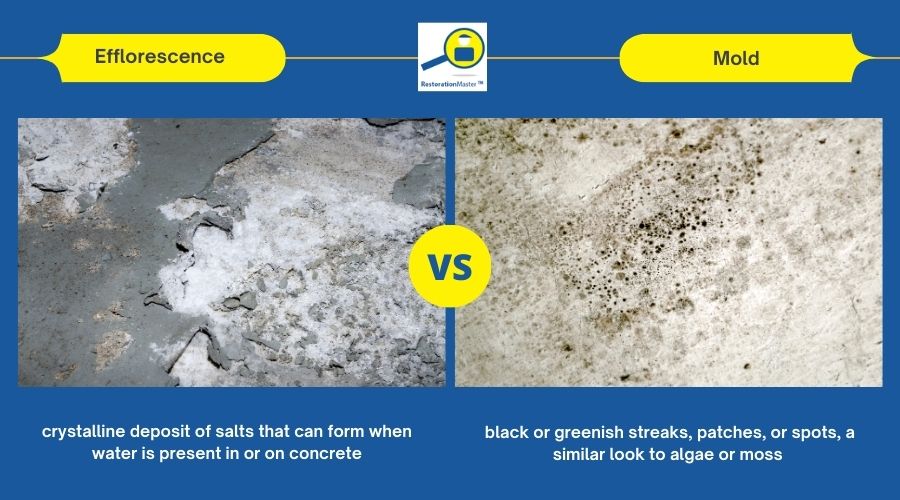
To determine whether you’re dealing with efflorescence or moldMold is a type of fungus that grows in damp or humid conditi... More on concrete, you can consider factors such as the appearance (powdery white for efflorescence, colored patches for moldMold is a type of fungus that grows in damp or humid conditi... More), location (efflorescence typically forms on the surface while moldMold is a type of fungus that grows in damp or humid conditi... More can grow on the surface or within pores), and the presence of moisture sources nearby. Additionally, efflorescence can often be brushed or washed away, while moldMold is a type of fungus that grows in damp or humid conditi... More may require more intensive cleaning and possibly treatment to prevent regrowth.
Why Does Mold Appear on Concrete?
MoldMold is a type of fungus that grows in damp or humid conditi... More appears on concrete surfaces primarily due to moisture accumulation or if there is any existing water damage. Concrete is porousPorous describes a material that contains small openings or ... More, so when it gets wet and stays damp, it creates an environment ideal for moldMold is a type of fungus that grows in damp or humid conditi... More growth. Here are some of the conditions moldMold is a type of fungus that grows in damp or humid conditi... More needs to grow:
- OxygenOxygen is a chemical element essential for combustion and li... More
- Warm temperature
- Water, humidityHumidity is the amount of moisture or water vapor present in... More, or dampness
- Any type of dirt, dust or insulationInsulation is a material used in buildings to reduce the tra... More for food sources
How to Get Rid of Mold on Concrete?
It can be difficult to get rid of moldMold is a type of fungus that grows in damp or humid conditi... More from concrete surfaces. Attempting to remove the moldMold is a type of fungus that grows in damp or humid conditi... More yourself can also be very harmful to your health. You will need to call a professional mold remediation company to clean it for you and ensure that it does not come back. If you do confirm that you have moldMold is a type of fungus that grows in damp or humid conditi... More on your concrete surfaces, you should take these steps right away:
- Block off the space: Make sure that people do not enter the area that has been affected by moldMold is a type of fungus that grows in damp or humid conditi... More as exposure can cause health issues. This is especially true for those who have asthma, allergies or are immunocompromised. Use tape and plastic tarp to seal off the area until it has been cleaned.
- Find a moldMold is a type of fungus that grows in damp or humid conditi... More professional: If you have moldMold is a type of fungus that grows in damp or humid conditi... More growing on concrete at your property, make sure to call the professionals as they can:
- Inspect the area and confirm if you have moldMold is a type of fungus that grows in damp or humid conditi... More present
- Contain the area and start with moldMold is a type of fungus that grows in damp or humid conditi... More removal
- Clean and dry the area once the cause has been addressed
- Apply a penetrating concrete sealant to make sure the moldMold is a type of fungus that grows in damp or humid conditi... More does not return.
How to Prevent Mold on Concrete?
MoldMold is a type of fungus that grows in damp or humid conditi... More on concrete can be remediated by professionals as they have the proper tools, equipment, and methods to effectively remove it. However, it is always best to prevent the formation of moldMold is a type of fungus that grows in damp or humid conditi... More at your property than paying to have it removed. Here are a few things you can do to prevent moldMold is a type of fungus that grows in damp or humid conditi... More at your property:
- Make sure you don’t have water seepageSeepage is the slow movement of water or other fluids throug... More: Get your foundation inspected so you can be sure that you do not have water permeating through the basement or the walls.
- Roof runoffRunoff is water from rain or other sources that flows over s... More should be directed away from your home: Always make sure to clean your gutters. Also, water should be directed away from the property’s foundation.
- Water should be redirected from your foundation: Any type of rainfall or floodingFlooding is the overflow or accumulation of water in areas t... More can cause pressure. This is why landscaping should be directing water away from your home or business. Installing a French drain can also help.
- All surfaces should be clean: You should keep concrete surfaces clean by sweeping, vacuuming, and using a dry mop to clean up any dirt or debris.
- Always make sure to check the basement, garage, or a crawl space for moldMold is a type of fungus that grows in damp or humid conditi... More: MoldMold is a type of fungus that grows in damp or humid conditi... More can grow on all types of concrete surfaces; however, it does need moisture to grow. This is where you should be vigilant by checking for water damage and making sure to call the professionals so you can prevent further damage.
Is Mold on Concrete Dangerous?
It is important to note that moldMold is a type of fungus that grows in damp or humid conditi... More on concrete can be harmful for your health. This is especially true for black moldMold is a type of fungus that grows in damp or humid conditi... More. However, if you have allergies or health issues it can be even more dangerous as it can make various conditions worse with prolonged exposure. This is why it is important to react right away if you notice moldMold is a type of fungus that grows in damp or humid conditi... More at your home or business. This way the issue can be remediated, and you can ensure a safe environment.
Mold Remediation Services From RestorationMaster Experts
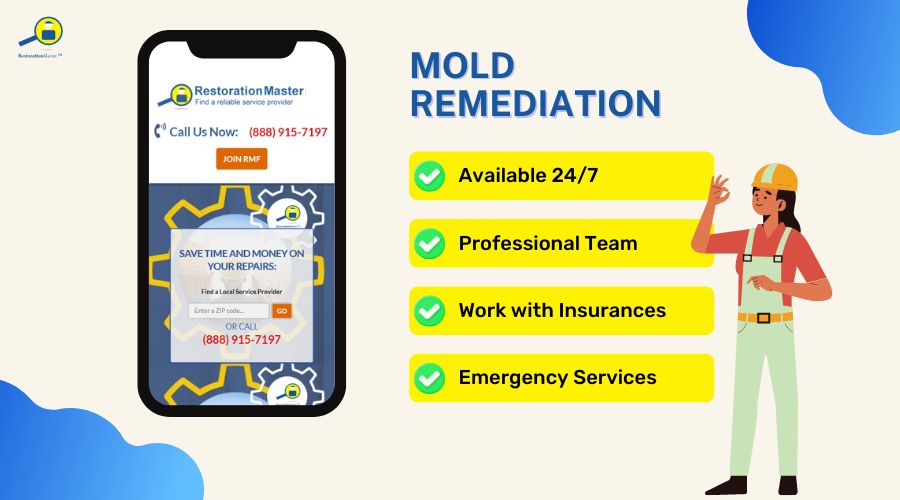
Have you experienced moldMold is a type of fungus that grows in damp or humid conditi... More at your home or business? RestorationMaster can help you find a mold remediation specialist near you. The professionals we work with have the proper tools, equipment, and methods to get rid of moldMold is a type of fungus that grows in damp or humid conditi... More from your home or business quickly and efficiently. They can effectively remove moldMold is a type of fungus that grows in damp or humid conditi... More from all types of surfaces, including concrete surfaces, and prevent it from coming back. You can rest assured that trained and licensed mold remediationMold remediation is the process of identifying, removing, an... More technicians can find and remove all moldMold is a type of fungus that grows in damp or humid conditi... More growth from your property.










